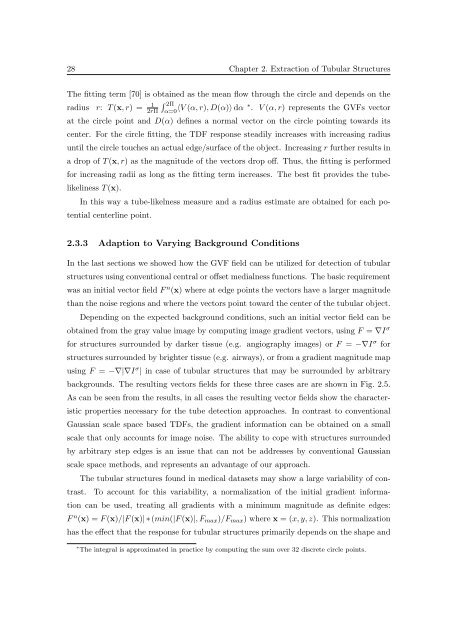Segmentation of 3D Tubular Tree Structures in Medical Images ...
Segmentation of 3D Tubular Tree Structures in Medical Images ...
Segmentation of 3D Tubular Tree Structures in Medical Images ...
Create successful ePaper yourself
Turn your PDF publications into a flip-book with our unique Google optimized e-Paper software.
28 Chapter 2. Extraction <strong>of</strong> <strong>Tubular</strong> <strong>Structures</strong><br />
The fitt<strong>in</strong>g term [70] is obta<strong>in</strong>ed as the mean flow through the circle and depends on the<br />
radius r: T (x, r) = 1 ∫ 2Π<br />
2rΠ α=0 〈V (α, r), D(α)〉 dα ∗ . V (α, r) represents the GVFs vector<br />
at the circle po<strong>in</strong>t and D(α) def<strong>in</strong>es a normal vector on the circle po<strong>in</strong>t<strong>in</strong>g towards its<br />
center. For the circle fitt<strong>in</strong>g, the TDF response steadily <strong>in</strong>creases with <strong>in</strong>creas<strong>in</strong>g radius<br />
until the circle touches an actual edge/surface <strong>of</strong> the object. Increas<strong>in</strong>g r further results <strong>in</strong><br />
a drop <strong>of</strong> T (x, r) as the magnitude <strong>of</strong> the vectors drop <strong>of</strong>f. Thus, the fitt<strong>in</strong>g is performed<br />
for <strong>in</strong>creas<strong>in</strong>g radii as long as the fitt<strong>in</strong>g term <strong>in</strong>creases. The best fit provides the tubelikel<strong>in</strong>ess<br />
T (x).<br />
In this way a tube-likelness measure and a radius estimate are obta<strong>in</strong>ed for each potential<br />
centerl<strong>in</strong>e po<strong>in</strong>t.<br />
2.3.3 Adaption to Vary<strong>in</strong>g Background Conditions<br />
In the last sections we showed how the GVF field can be utilized for detection <strong>of</strong> tubular<br />
structures us<strong>in</strong>g conventional central or <strong>of</strong>fset medialness functions. The basic requirement<br />
was an <strong>in</strong>itial vector field F n (x) where at edge po<strong>in</strong>ts the vectors have a larger magnitude<br />
than the noise regions and where the vectors po<strong>in</strong>t toward the center <strong>of</strong> the tubular object.<br />
Depend<strong>in</strong>g on the expected background conditions, such an <strong>in</strong>itial vector field can be<br />
obta<strong>in</strong>ed from the gray value image by comput<strong>in</strong>g image gradient vectors, us<strong>in</strong>g F = ∇I σ<br />
for structures surrounded by darker tissue (e.g. angiography images) or F = −∇I σ for<br />
structures surrounded by brighter tissue (e.g. airways), or from a gradient magnitude map<br />
us<strong>in</strong>g F = −∇|∇I σ | <strong>in</strong> case <strong>of</strong> tubular structures that may be surrounded by arbitrary<br />
backgrounds. The result<strong>in</strong>g vectors fields for these three cases are are shown <strong>in</strong> Fig. 2.5.<br />
As can be seen from the results, <strong>in</strong> all cases the result<strong>in</strong>g vector fields show the characteristic<br />
properties necessary for the tube detection approaches. In contrast to conventional<br />
Gaussian scale space based TDFs, the gradient <strong>in</strong>formation can be obta<strong>in</strong>ed on a small<br />
scale that only accounts for image noise. The ability to cope with structures surrounded<br />
by arbitrary step edges is an issue that can not be addresses by conventional Gaussian<br />
scale space methods, and represents an advantage <strong>of</strong> our approach.<br />
The tubular structures found <strong>in</strong> medical datasets may show a large variability <strong>of</strong> contrast.<br />
To account for this variability, a normalization <strong>of</strong> the <strong>in</strong>itial gradient <strong>in</strong>formation<br />
can be used, treat<strong>in</strong>g all gradients with a m<strong>in</strong>imum magnitude as def<strong>in</strong>ite edges:<br />
F n (x) = F (x)/|F (x)| ∗ (m<strong>in</strong>(|F (x)|, F max )/F max ) where x = (x, y, z). This normalization<br />
has the effect that the response for tubular structures primarily depends on the shape and<br />
∗ The <strong>in</strong>tegral is approximated <strong>in</strong> practice by comput<strong>in</strong>g the sum over 32 discrete circle po<strong>in</strong>ts.















